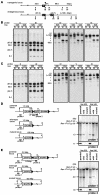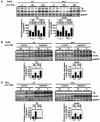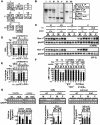A single nucleotide mutation in the mouse renin promoter disrupts blood pressure regulation
- PMID: 18259612
- PMCID: PMC2230662
- DOI: 10.1172/JCI33824
A single nucleotide mutation in the mouse renin promoter disrupts blood pressure regulation
Abstract
Renin, a major regulatory component of the renin-angiotensin system, plays a pivotal role in regulating blood pressure and electrolyte homeostasis and is predominantly expressed in the kidney. Several cAMP-responsive elements have been identified within renin gene promoters. Here, we study how 2 such elements, renin proximal promoter element-2 (RP-2) and overlapping cAMP and negative regulatory elements (CNRE), affect the transcriptional regulation of renin. We generated Tg mice (TgM) bearing BACs containing either WT or mutant RP-2 or CNRE, integrated at single chromosomal loci. Analysis of the TgM revealed that RP-2 was essential to basal promoter activity in the kidney, while renin mRNA levels did not significantly change in any tissues tested in the CNRE mutant TgM. To evaluate the physiological significance of these mutations, we used the BAC Tg to rescue hypotensive Renin-null mutant mice. As predicted, no renin expression was observed in the kidneys of RP-2 mutant/Renin-null compound mice, whereas renin expression in CNRE mutant compound mice was indistinguishable from that in control mice. Consistent with this, RP-2 mutant animals were hypotensive, while CNRE mutants had normal blood pressure. Thus, transcriptional regulation of renin expression via RP-2 but not CNRE is critical for blood pressure regulation by this gene.
Figures





Similar articles
-
A mouse renin distal enhancer is essential for blood pressure homeostasis in BAC-rescued renin-null mutant mice.J Recept Signal Transduct Res. 2014 Oct;34(5):401-9. doi: 10.3109/10799893.2014.908917. Epub 2014 Apr 15. J Recept Signal Transduct Res. 2014. PMID: 24734888
-
LXRalpha functions as a cAMP-responsive transcriptional regulator of gene expression.Proc Natl Acad Sci U S A. 2000 Jul 18;97(15):8513-8. doi: 10.1073/pnas.100519097. Proc Natl Acad Sci U S A. 2000. PMID: 10890879 Free PMC article.
-
cAMP target sequences enhCRE and CNRE sense low-salt intake to increase human renin gene expression in vivo.Pflugers Arch. 2011 May;461(5):567-77. doi: 10.1007/s00424-011-0956-z. Epub 2011 Mar 22. Pflugers Arch. 2011. PMID: 21424707
-
Regulation of renin: new evidence from cultured cells and genetically modified mice.J Mol Med (Berl). 2000;78(3):130-9. doi: 10.1007/s001090000089. J Mol Med (Berl). 2000. PMID: 10868475 Review.
-
Transcriptional regulation of renin: an update.Hypertension. 2005 Jan;45(1):3-8. doi: 10.1161/01.HYP.0000149717.55920.45. Epub 2004 Nov 15. Hypertension. 2005. PMID: 15545507 Review.
Cited by
-
Synthetic DNA fragments bearing ICR cis elements become differentially methylated and recapitulate genomic imprinting in transgenic mice.Epigenetics Chromatin. 2018 Jun 29;11(1):36. doi: 10.1186/s13072-018-0207-z. Epigenetics Chromatin. 2018. PMID: 29958543 Free PMC article.
-
Control of renin [corrected] gene expression.Pflugers Arch. 2013 Jan;465(1):13-21. doi: 10.1007/s00424-012-1110-2. Epub 2012 May 11. Pflugers Arch. 2013. PMID: 22576577 Free PMC article. Review.
-
A polymorphism of the renin gene rs6682082 is associated with essential hypertension risk and blood pressure levels in Korean women.Yonsei Med J. 2015 Jan;56(1):227-34. doi: 10.3349/ymj.2015.56.1.227. Yonsei Med J. 2015. PMID: 25510769 Free PMC article.
-
Long-Range Control of Renin Gene Expression in Tsukuba Hypertensive Mice.PLoS One. 2016 Nov 18;11(11):e0166974. doi: 10.1371/journal.pone.0166974. eCollection 2016. PLoS One. 2016. PMID: 27861631 Free PMC article.
-
Long human CHGA flanking chromosome 14 sequence required for optimal BAC transgenic "rescue" of disease phenotypes in the mouse Chga knockout.Physiol Genomics. 2010 Mar 3;41(1):91-101. doi: 10.1152/physiolgenomics.00086.2009. Epub 2009 Dec 15. Physiol Genomics. 2010. PMID: 20009010 Free PMC article.
References
-
- Yanai K., et al. Renin-dependent cardiovascular functions and renin-independent blood-brain barrier functions revealed by renin-deficient mice. J. Biol. Chem. 2000;275:5–8. - PubMed
-
- Clark A.F., et al. Renin-1 is essential for normal renal juxtaglomerular cell granulation and macula densa morphology. J. Biol. Chem. 1997;272:18185–18190. - PubMed
-
- Bader M., Ganten D. Regulation of renin: new evidence from cultured cells and genetically modified mice. J. Mol. Med. 2000;78:130–139. - PubMed
Publication types
MeSH terms
Substances
LinkOut - more resources
Full Text Sources
Other Literature Sources
Molecular Biology Databases
Research Materials
Miscellaneous

